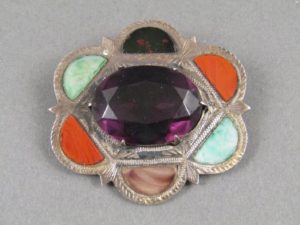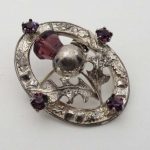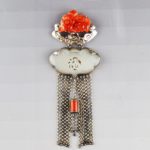
A Scottish Agate Brooch set in Hallmarked Silver, assayed in Glasgow and showing the maker’s mark for Ward Brothers.
Sold for $150 at Hutter Auctions NYC
Agate is a form of chalcedony (quartz, silicon dioxide) called Cryptocrystalline typically filling cracks and gas cavities in ancient lava flows; Scotland’s agates are from the Old Red Sandstone age (around 400 million years old).
Used on a small scale for the manufacture of jewellery for at least two hundred years, agate is one of Scotland’s best-known semi-precious stones. Cut into thin pieces it is nearly transparent but it less brittle than normal quartz, which helps to explain that stones found in cufflinks, bracelets and brooches made during the Victorian Era (140 years of age) show so little wear.
Reference: http://www.thistleandbroom.co.uk/scotland/agate.htm.
The stone was given its name by Theophrastus, a Greek philosopher and naturalist, who discovered the stone along the shore line of the river Achates (Greek: Ἀχάτης) in present-day Sicily, sometime between the 4th and 3rd centuries BC. Colourful agates and other chalcedonies were obtained over 3,000 years ago from the Achates River, now called Dirillo.
Agate is one of the most common materials used in the art of hardstone carving, and has been recovered at a number of ancient sites, indicating its widespread use in the ancient world; for example, archaeological recovery at the Knossos site on Crete illustrates its role in Bronze Age Minoan culture.
Most agates occur as nodules in volcanic rocks or ancient lavas, in former cavities produced by volatiles in the original molten mass, which were then filled, wholly or partially, by siliceous matter deposited in regular layers upon the walls. Agate has also been known to fill veins or cracks in volcanic or altered rock underlain by granitic intrusive masses. Such agates, when cut transversely, exhibit a succession of parallel lines, often of extreme tenuity, giving a banded appearance to the section. Such stones are known as banded agate, riband agate and striped agate.


